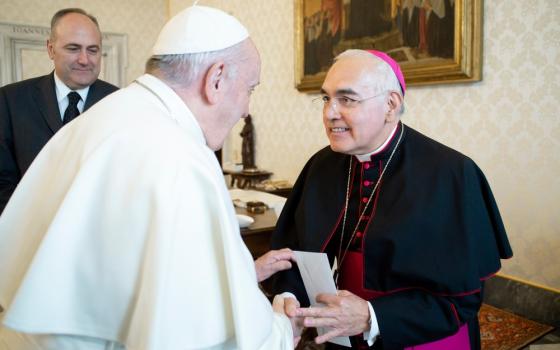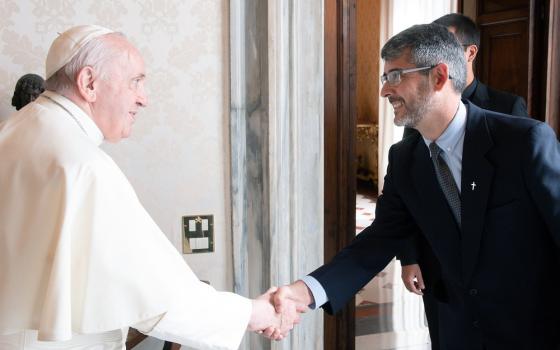Evaluating an event with the scale and complexity of the Fifth General Conference of the Bishops of Latin America and the Caribbean (CELAM), which drew to a close Thursday in Aparecida, Brazil, following 19 days of deliberations among 162 bishops, 81 other participants, and 23 observers and theological advisors, is inevitably an exercise in selective perception. To some extent, it comes down to whether one is inclined to see the glass as half-full, or half-empty.
On the half-full side of the ledger, one can cite some arguably significant results:
- A frank admission from the bishops that 500 years of Roman Catholicism as a near-monopoly in Latin America in some ways put the church to sleep, leaving it content with the formal externals of religion such as baptism, but often failing to impart any real sense of personal faith;
- A consequent call for a "Great Continental Mission," driven by old-fashioned, door-to-door pastoral outreach, rather than sitting around in parishes and waiting for people to show up. (Brazilian Cardinal Claudio Hummes used the much less euphonic phrase "domiciliary missionary visits," but it amounts to the same thing);
- A more ecumenical tone than has often been the case in Latin America, recognizing that in light of growing secularization and a sometimes hostile political climate, the various Christian churches need to stand together;
- A deeper ecological awareness;
- A cautious embrace of the core legacy of liberation theology, including the option for the poor, the concept of structural sin, ecclesial base communities, and the "see-judge-act" method of social discernment, though always in the context of the primacy of individual holiness, as well as clarity about the church's proclamation of Jesus Christ as the Son of God and lone Savior of the world.
Skeptics, however, can poke holes in each of these outcomes.
Recognition that far too many Catholics in Latin America are spiritually adrift, for example, doesn't strike some observers as especially bold. What would have been more surprising, they say, is if someone had tried to deny it.
Cardinal Claudio Hummes of Brazil, the Prefect of the Congregation for Clergy in Rome, put the reality bluntly: "The majority of Catholics on this continent no longer participate, or never have participated, in the life of our ecclesial communities," he said. "We baptized them, but for many reasons, we never really evangelized them sufficiently."
The fruits of that inattention are obvious. During the 20th century, more Catholics converted to Protestantism in Latin America, especially Pentecostal and Evangelical movements, than in Europe during the 16th century Protestant Reformation. There's also a growing phenomenon of abandonment of religious faith altogether, especially among the poor along the peripheries of Latin America's sprawling mega-cities. In Brazil, to take one example, the percentage of people reporting no religious affiliation went from 0.7 percent in 1980 to 7.3 percent in 2000, more than a ten-fold increase in just 20 years.
In the past, the tendency of some Latin American bishops has been to blame these losses on outside forces -- on deceitful proselytism from the "sects," on financial and logistical support from Protestants in the United States, even on supposed policies of the United States government aimed at undermining the Catholic identity of Latin America as an impediment to the spread of free-market capitalism. In that light, the breakthrough in Aparecida may be the bishops' acknowledgement that the fault lays not in their stars, but in themselves.
The real question is what to do about it, and here the bishops left things vague. Their bold call for a "Great Continental Mission" foundered during behind-closed-door debates about whether CELAM actually has the authority to launch such a project, or whether that's something for individual bishops and bishops' conferences. Because there was no time to resolve that ecclesiological conundrum, the bishops decided to put it off until the next meeting of the executive body of CELAM in Havana, Cuba, in July. (This debate forms the background to a comment from Italian Cardinal Giovanni Battista Re, Prefect of the Vatican's Congregation for Bishops, who in a concluding address referred to the continental mission "that we decided upon here, and that we leave in the hands of the episcopal conferences and each bishop of Latin America and the Caribbean.")
In effect, this means the much-ballyhooed "Great Continental Mission," in the sense of a unified continent-wide effort, may never get off the ground.
If it does, virtually every observer agrees that one key element has to be a much more aggressive role on the part of the laity, given the severe priest shortages which afflict the continent. In the United States, the priest-to-person ratio is 1-1,300, but the average is Latin America is 1-7,000, and in many places the situation is far worse. Aside from committing themselves to promoting a "mature laity, co-responsible in the mission of announcing and making visible the Reign of God," the bishops did not offer any clear sense of what this lay empowerment might look like.
Even some bishops seemed ambivalent about what had been accomplished. Bishop Noberto Strotmann Hoppe of Chosica, Peru, offered a tepid assessment: "No conference of this type can address problems, whether at the international level or in Latin American society, nor from a theological perspective as well, in such a short period of time," he said.
As for the ecumenical dimension, the atmospherics were certainly irenic. One of the few occasions the time limit for floor speeches was extended, for example, was when a Methodist pastor from Argentina urged that the "diverse Christian presence" in Latin America not be marked by "confrontation and competition," but by "the common vocation to be disciples and missionaries of Our Lord Jesus Christ." That speech also drew one of the few rounds of applause, which is technically a violation of protocol. Yet there were no new concrete proposals for advancing relations with other Christian bodies or with other faiths. A similar point can be made about the bishops' commitment to ecology, with strong language but no new policies.
With regard to liberation theology, the texts from Aparecida often read like compromise documents, with something to please both friends and foes.
The bishops explicitly affirmed liberation theology's famous option for the poor, but tweaked it to become a "preferential and evangelical option," making clear this is no merely political or social commitment. At a concluding press conference, Cardinal Oscar Rodriguez Maradiaga of Honduras took pains to stress that this option "is not ideologized." Similarly, the bishops said that their final document was structured according to the "see-judge-act" method, but gave it a Trinitarian frame (seeing "with the eyes of faith," judging "according to the Gospel of Jesus," and acting under "the inspiration of the Holy Spirit.") The explicit confirmation of the "see-judge-act" method was considered especially telling, since it had been dropped in the 1992 edition of CELAM in Santo Domingo.
On balance, the results may be judged as a net gain for the liberationists, if only because the movement has so often been pronounced dead. Alas, a Mexico-based journal sympathetic to liberation theology, offered the early take that Aparecida was "positive for the Latin American church."
The bishops' assessment of liberation theology as a living force was clear from the decision to meet with a group of liberation theologians prior to the opening of the conference, and from the fact that several acted as theological advisors during the meeting. Asked about the relationship, Rodriguez at one point told the press, "There is no opposition or antagonism, by any means. We have been open to them from the beginning, and I can say that we remain in contact with them." Bishop Roque Paloschi of Roraima, Brazil, was more direct: "The theology of liberation lives."
The bishops closed the conference with a concrete illustration of what a "preferential and evangelical option for the poor" means, addressing a message to the leaders of G-8 nations who will meet in Heiligendamm, Germany, June 6-8. They asked the G-8 leaders to "guide the world economy toward sustainable, ecological, and human development," saying that the peoples of Latin America "suffer greatly from unjust relations between rich and poor countries." The bishops said that "one of the most urgent tasks of our time" is to eliminate extreme poverty by 2015, and that doing so "is inseparably linked with world peace and security."
The idea in Aparecida was apparently to endorse liberation theology's stress on social justice, yet integrate it more fully into the church's overall mission. Whether that will actually happen, or whether the Latin American church will continue to be divided, in effect, between a left wing that attacks structural sin but downplays more traditional forms of spirituality, and a right wing that often sees political and social questions as a distraction from personal holiness, remains to be seen. Moreover, the tug-of-war over vocabulary associated with liberation theology left little room for what some observers consider the more pressing question of how to help the continent's poor. While many bishops and theologians fault neo-liberal economic policies, others argue that the basic problems are instead top-heavy government bureaucracies and widespread corruption. Those discussions were largely left for another day.
CELAM's final report was not made public at the close of the meeting, but will instead be presented to Pope Benedict XVI June 11. Towards the end of the conference, there was a frenzy of activity in an attempt to bring the document to closure. With just two days remaining, 2,097 proposed amendments had been submitted, leaving the editorial committee to make judgments on the fly. (Some critics charged that the final document reflects the views of the editorial committee more than the entire assembly.) On Wednesday, members were asked to vote "placet" or "non placet" on each of the proposed text's sections, with no option for expressing conditional approval. The final text is roughly 118 pages long, consisting of 10 chapters.
In the end, whether CELAM produced anything that could truly reinvigorate the church in Latin America, home to almost half of the Catholics in the world, will only become clear when -- and, it must be said, if -- the conference's documents are studied, digested, and translated into pastoral action.
* * *
Votes in favor of the meeting's conclusions were fairly overwhelming; the concluding message, for example, was adopted by a vote of 110 in favor, 16 against, and two ballots left blank. The vote on the final document was 127 in support, and just two opposed.
Nevertheless, CELAM officials were extraordinarily sensitive to any appearance of division. The lone official denial of a news story during the month-long conference, for example, came on May 30, in response to a report the day before from ACI Prensa, a Catholic news agency based in Lima, Peru, to the effect that 30 bishops had evidently left the CELAM conference because they were not taking part in the voting on its documents.
The ACI Prensa account, which was actually a marginal note in a cutline under a photograph, was based on the common-sense observation that the official number of voting bishops was 162, while the actual number of votes cast towards the end was around 128 or 129.
The specter of bishops leaving a meeting rather than being forced to vote "no" has a long pedigree in Catholic history; it's what happened during the First Vatican Council in 1870, for example, when bishops opposed to the declaration on papal infallibility boarded trains rather than casting a ballot obviously displeasing to Pope Pius IX.
In that light, CELAM officials were quick to insist that such was not the case this time around.
In fact, their denial indicated, only nine bishops left the conference, and most of them were Vatican officials or bishops from outside Latin America who were either called away on urgent business, or whose health was weak. Only three Latin Americans, the statement said, went home early, and all for pastoral reasons. Officials never did, however, offer a clear explanation for why the vote totals were so much lower than the official number of voting bishops.
* * *
One of the best books on the Second Vatican Council (1962-65) was written by a non-Catholic: Robert McAfee Brown, a Presbyterian minister and professor at Stanford, who died in 2001. Brown was a Protestant observer at Vatican II, and in 1964 Doubleday published his account of the experience, titled An Observer in Rome: A Protestant Report on the Vatican Council.
It was Brown, for example, who offered the best description of a dramatic day at Vatican II -- Nov. 8, 1963, when Cardinal Josef Frings of Cologne lambasted the methods of the Holy Office, the Vatican's doctrinal agency, calling it "a source of scandal to the world." That speech, in one of church history's neat ironies, was partly ghost-written by Frings' peritus, or theological expert, a young German theologian by the name of Fr. Joseph Ratzinger. Brown reported that the Frings speech had "blown the dome off of St. Peter's."
(The Frings speech, by the way, provoked one of Vatican II's most memorable bon mot. Cardinal Alfredo Ottaviani, the legendary Prefect of the Holy Office, observed with evident skepticism that Frings had called for greater "collegiality." Ottaviani asked rhetorically if His Eminence recalled the one collegial act recorded in the four Gospels, which came in the Garden of Gethsemani when Jesus was arrested. That act? Ottaviani quoted it directly: "They all fled.")
In a similar spirit, perhaps the best writing on the Fifth General Conference of the Bishops of Latin America and the Caribbean was by another Protestant observer: Harold Segura, a Baptist minister from Costa Rica and a professor at the Evangelical University of the Americas. From the opening of the CELAM meeting, Segura posted daily entries to a blog called "A Shepherd in the CELAM." (The blog can be found here:
http://fromaparecida.blogspot.com/) His entries are in Spanish, and a few days later some were translated into English.
Like Brown, Segura's sympathies are clearly with the progressives, and many of his entries evaluate CELAM's work from the perspective of his hopes for a strong social message and greater ecumenical openness. Yet equally interesting are the small nuggets he related from the margins of CELAM, which offered a bit of insider flavor.
On May 28, for example, Segura described being asked to read one of the Scripture passages at CELAM's daily Mass. The invitation was intended as a signal of ecumenical fraternity, and that was how Segura took it. Ironically, however, the reading came from the Book of Ecclesiasticus, considered by Protestants to be "apocryphal" and hence not part of their Bible. Here Segura was, being asked to read from it on live television -- and, to add insult to injury, to declare it "The Word of God." Part of him recoiled, yet he didn't want to rain on the ecumenical parade.
In the end, Segura devised a solution, which he described on his blog. When he finished reading the passage, Segura wrote, he pronounced the phrase "The Word of God" with just a hint of raised inflection, converting it from a declaration into an interrogatory -- "The Word of God?"
As Segura described it, everyone seemed to be in good humor, including Cardinal Re, who thanked Segura for the reading. It is from such small steps, Segura said, that ecumenical progress is constructed.
The e-mail address for John L. Allen Jr. is jallen@ncronline.org




